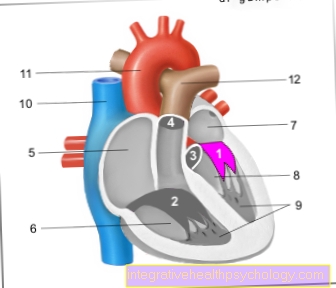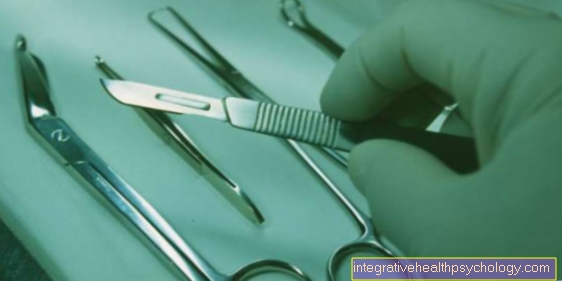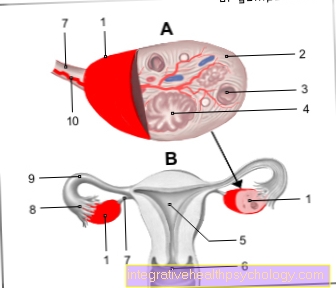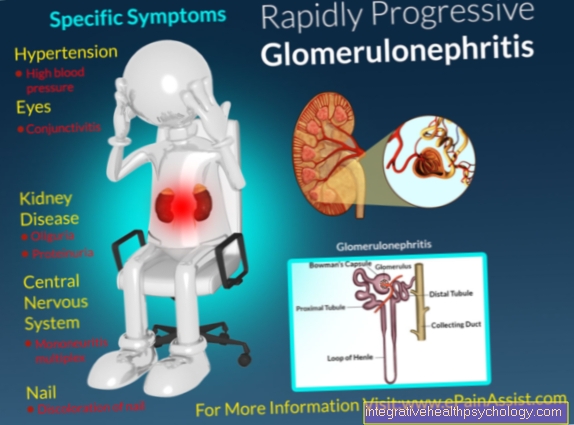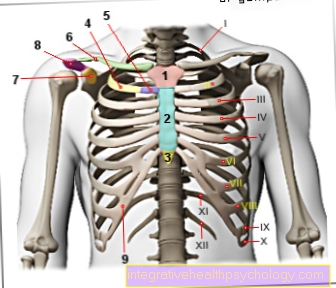Eye socket infection
Definition - What is an eye socket infection?
With an eye socket infection, the orbit (eye socket) is inflamed. The orbit forms a bony pit in the skull, in which the eyeball and eye muscles, connective tissue, blood vessels and nerves are located. The eye socket is in close spatial relationship to the frontal sinus, the cranial cavity and the maxillary sinus, which is why inflammation from this area can easily spread.
Orbital inflammation is a serious condition that can lead to serious complications. Due to the proximity to the cranial cavity and the brain, the inflammation can lead to a life-threatening blockage of the cerebral arteries or a brain abscess.

Detecting an eye socket infection
What are the symptoms of an orbital inflammation?
An eye socket infection causes pain, which is most noticeable when you move your eyes. Due to movement disorders of the eye muscles, the sick people have problems seeing: typically double vision occurs because the eyeballs can no longer be aligned correctly. The inflammation causes the tissue within the eye socket to swell. The other symptoms of an eye socket infection can vary greatly, depending on the cause. Other symptoms include swelling of the upper and lower eyelids, watery eyes, problems closing the eyelids and redness. Headache or can be an indication of an eye socket infection.
What kind of pain does an eye socket infection cause?
The outer eye muscles as well as numerous nerves and blood vessels are located in the eye socket. If there is inflammation, the tissue inside the eye socket swells a lot, which can cause severe pain. Moving the eyes in particular is extremely painful and, in the worst case, the eyeballs cannot be moved at all.
In addition, the inflammation and swelling increase the pressure in the eye socket, causing a headache.
Treating an eye socket infection
How is eye socket infection treated?
Treatment for orbital inflammation depends on the cause of the condition. In general, inflammation is treated with anti-inflammatory drugs, such as ibuprofen. If there is an endocrine orbitopathy, special drugs, so-called thyreostatics or thyroid blockers, are used. In severe cases, glucocorticoids are used to help the inflammation subside. Rheumatic diseases that affect the eye are also often treated with these drugs.
Orbital phlegmon are serious diseases that can lead to serious complications and even blindness or death. Therefore, the suspicion of a purulent eye socket infection is enough to start antibiotic therapy immediately. This is given in the form of an infusion. In most cases, surgery must also be performed so that the accumulation of pus can drain away.
How is eye socket infection diagnosed?
If an eye socket infection is suspected, an ophthalmologist should be consulted immediately. The doctor asks the patient questions about the medical history, previous illnesses and current complaints. He then does an eye exam. The inflammation parameters in the body can be examined using a blood test.
Occasionally, it may be necessary to take a tissue sample from the eye socket in order to examine the tissue under the microscope. For some questions, imaging of the eye socket using magnetic resonance imaging (MRI) or computed tomography (CT) must also be performed.
In the clinical picture of an endocrine orbitopathy, an increase in the size of the structures within the eye socket characteristically leads to a pronounced protrusion of the eyeballs ("googly eyes", medical exophthalmos). Often the patients also suffer from palpitations and the enlarged thyroid gland causes a goiter (goiter). The exophthalmos can be unilateral or bilateral.
Preventing eye socket infections
What are the causes of an eye socket infection?
An eye socket infection can develop as a result of a bacterial infection. Often times, a sinus infection spreads to the eye socket and a purulent eye socket infection occurs. A collection of pus within the eye socket is medically called an orbital phlegmon. In general, in almost every infection of the head and face area, the bacteria can spread to the eye socket and cause inflammation there. This applies, for example, to tooth root inflammation or a stye (hordeolum) on the inside of the eyelid.
Systemic inflammation, i.e. diseases that affect the entire body, can also spread to the eye and thus cause inflammation of the orbit. These include above all rheumatic diseases, such as Wegener's granulomatosis (granulomatosis with polyangiitis). In this condition, the small blood vessels throughout the body become inflamed, a condition called vasculitis. Other causes of inflammation of the eye socket are tumors of the eye socket, inflammation of the optic nerve (optic neuritis) or inflammation of the muscles in the eye (ocular myositis).
Diseases of the thyroid gland are also clinically relevant for inflammation of the orbit. Graves' disease is an autoimmune disease in which the thyroid gland overactive (hyperthyroidism) occurs. As a result, the eye socket can become inflamed and so-called endocrine orbitopathy develops.
Course of an orbital inflammation
Duration of complaints
The duration of an orbital inflammation depends on the extent of the inflammation. The further the inflammation has spread, the more difficult it is to treat and the longer it will take for full healing to occur. It will take at least a week for the inflammation to subside completely.

